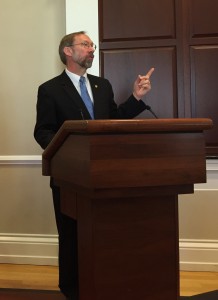Last week, the U.S. Environmental Protection Agency released a survey showing that $271 billion is needed to maintain and improve the nation’s wastewater infrastructure, including the pipes that carry wastewater to treatment plants, the technology that treats the water, and methods for managing stormwater runoff. This story comes in the wake of national attention on our nation’s water infrastructure needs gap, where it is estimated that an investment of $384 billion is needed over the next 20 years to maintain existing drinking water systems. In the shadow of these large and looming estimates, communities across the country are tasked with meeting the everyday challenges of providing and paying for environmental services, including providing clean drinking water and wastewater treatment.
Recognizing these and other growing environmental challenges facing communities, EPA created the Environmental Finance Advisory Board (EFAB) in 1989 to find ways to lower the costs of and increase investments in environmental and public health protection. As an independent advisory committee, EFAB focuses on lowering the cost of environmental protection, removing financial and programmatic barriers that raise costs, increasing public and private contribution in environmental facilities and services, and building state and local financial ability to meet environmental laws.
Members of EFAB met last week in Washington, DC, to continue discussions on how to meet the nation’s environmental finance challenges. Expertise on the board comes from diverse points of view, including membership from those in state and local governments, the banking and finance communities, business and industry, and nonprofit organizations. Jeff Hughes, Director of the Environmental Finance Center (EFC) at UNC Chapel Hill, was appointed to the board last year and attended the meeting last week. The Environmental Finance Centers also work closely with the EFAB to educate public officials about resources and strategies to help them meet regulatory requirements and ensure a healthy environment for their communities.

Some of the key discussions at recent EFAB meetings have been around EPA’s new Water Infrastructure and Resiliency Finance Center, which supports communities in developing dedicated sources of revenue for stormwater and green infrastructure programs, exploring public-private partnerships for water infrastructure projects, and financing of predevelopment activities for water infrastructure projects in communities. The center is part of the White House Build America Investment Initiative – a government-wide effort to increase infrastructure investment and promote economic growth by creating opportunities for state and local governments and the private sector to collaborate, expand public-private partnerships, and increase the use of federal credit programs. The Center reached its one-year anniversary this week and hosted an event to celebrate several initiatives towards its mission to act as a resource to communities that are financing drinking water, wastewater, and stormwater infrastructure.
One of these initiatives is to support communities interested in exploring public-private partnerships for water infrastructure projects. With support from the Center, the EFC at UNC is examining the potential benefits of such alternative water service delivery partnerships and mechanisms. This objective evaluation will provide analysis to assist decision makers in understanding the potential financial impacts (both positive and negative) of alternative water service delivery models and make informed decisions about the most effective approaches to financing and managing their water services. Products of this work, which include case studies and a business case analysis tool, will be available later this year.
To learn more about the Environmental Finance Advisory Board, including reports and other resources, visit: http://www.epa.gov/envirofinance/efab

